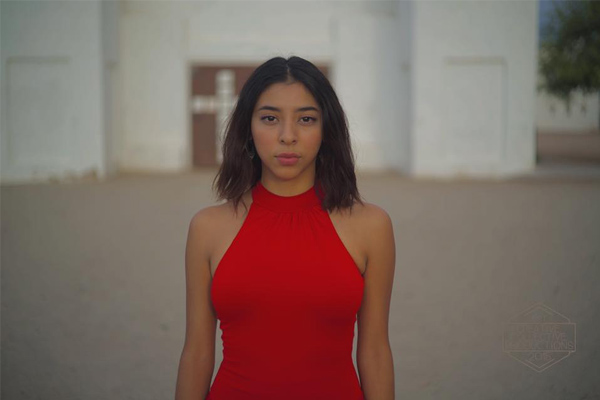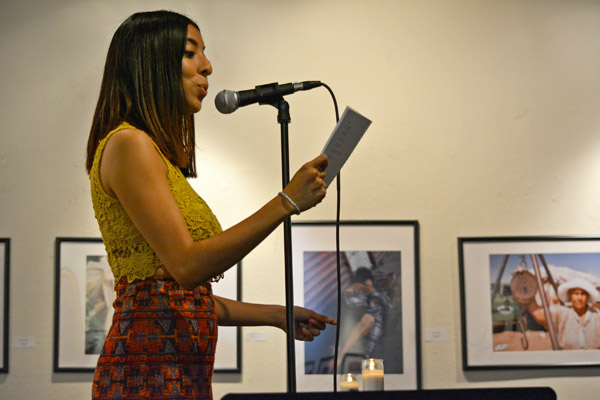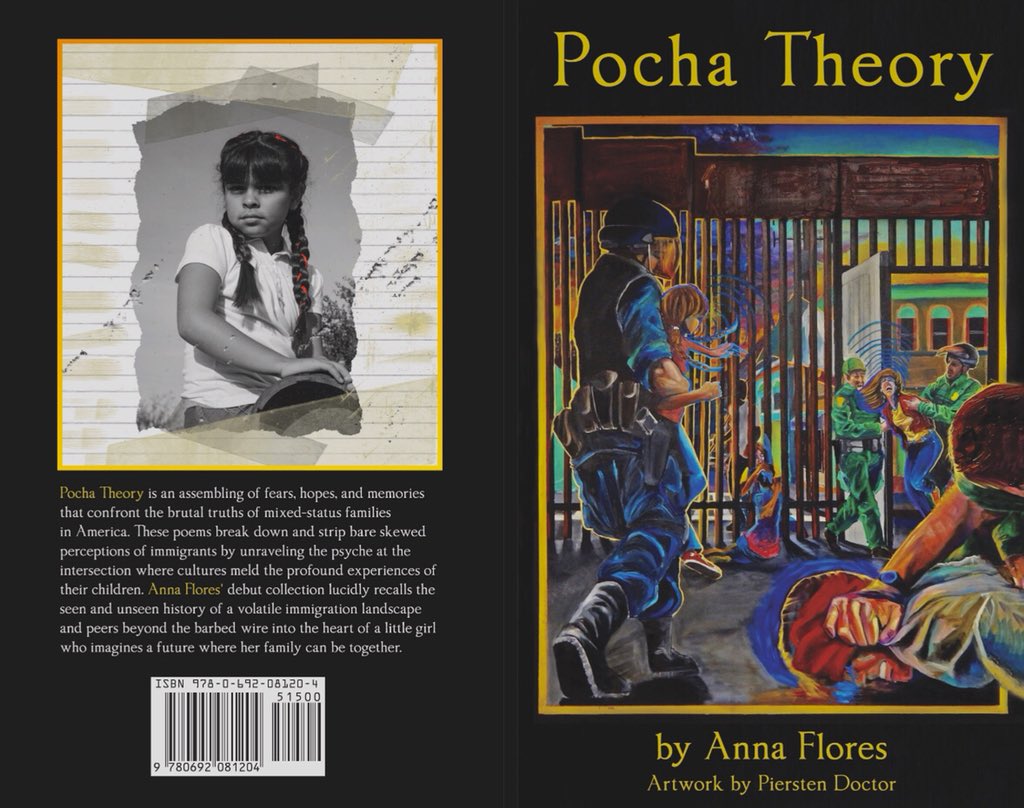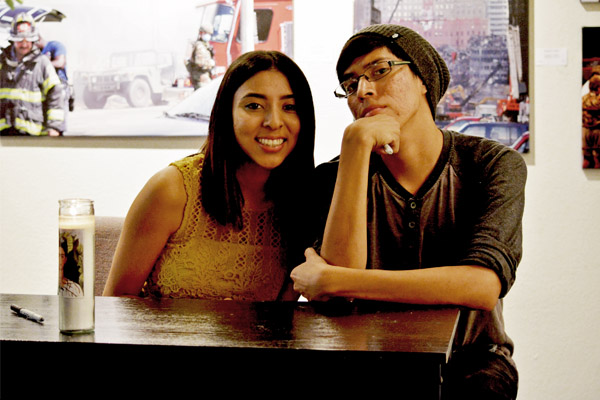#FrayLife Community Spotlight: Local Writer & Actress Anna Flores
Anna Flores is no stranger to performances. Born in Nogales and raised in Phoenix, the writer and actress has participated in and hosted several events in the Valley bringing awareness to cultural and political issues that hold extreme relevance, especially in the current climate.
Her first book of poetry, Pocha Theory, was launched at the Arizona Latino Arts and Cultural Center (ALAC) on 03/30/2018.
We chatted with Anna about a range of topics, from the process of publishing the collection to the importance of an upcoming event at the Abloom Salon & Gallery this Friday.
Did you grow up as a writer, or was your poetry something that developed when you went on to higher education?

Anna: English is my second language and learning English was sort of therapeutic for me in the midst of coping in a new culture and the poverty I was immersed in as my family and I tried to settle in Arizona. And so, I have always had a special bond with literature. I remember in first grade at P.T.Coe Elementary school in Phoenix, I was put in a second-grade class once a week because my reading and writing skills were above average. I remember feeling very scared and small at the time but there was a book, and I don’t recall the title but I remember being struck by this line that said something was like, “grass on my bare feet” and I was so moved by that metaphor so I copied that line into an assignment for my first grade class and my teacher was impressed by it and when she asked me how I came up with it, I told her the truth— that I had copied it from a book. Ever since then, I’ve been making my own metaphors, I think.
I think poetry is most like our human way of processing thought and trauma. The fragmented, imagistic form, to me, makes sense.
How long did it take for you to come up with what you considered to be your final product? Did your writing process change when trying to put together something that you considered publishable?
You know, I had a lot of trouble deciding when my book was done. I think every artist and every writer has that self-doubt that keeps us from presenting something.
I have been writing my whole life. I have journals from when I was 11 and although the subject-matter has changed depending on my world-view and perspective, the border itself has been a constant variable in my life. Behind every poem, even the love poems, and the death poems, there was the wall and the helplessness that I felt about it. By the beginning of 2017, I had two years worth of material that I decided to gather and understand them and really listen to what I was saying behind all of the clutter.
Pocha Theory was originally titled, “Good Girls Don’t Die” which were the same poems with a focus on my mental struggle as an indigenous, Mexican girl growing up in a mixed-status family. By the end of 2017, however, I was writing and editing these poems every single day- I mean it became an obsession. I knew that I still wasn’t listening well enough. Finally, I had a breakthrough when my nieces came to live with us from Mexico— they are U.S. citizens and we wanted them to get a better education than they were getting on the other side of the border. I saw myself in them. They are 13 and 7 years old and I knew what they were going through as they tried to integrate themselves in America and navigated their identities as brown, bi-cultural girls.
It felt as if my whole life was replaying in a loop. My nieces began speaking English and they would forget some words in Spanish but they still had a sharp Mexican tongue. My brother, their father, spent hundreds of dollars trying to hire a lawyer who could help him get a visa, he was scammed… these are all things that I experienced as a young girl and the book of poems transformed into an ode to my nieces, and more than that, to all the pochitas, all the displaced, all the children of deportees. The book became full of theories, of stories, of memories, of nightmares. Finally, I understood why I even began writing in the first place and it was a painful process to come to terms with.
At that moment it didn’t matter whether the book was finished, because it would never be finished. This book that I thought I was writing as a sort of memoir collection, was actually alive and happening. It was a hard lesson to accept. So I decided the right time to publish was now. I wanted my nieces to have a text-guide and some of the poems, I still work and edit but I hope the poetry community is forgiving enough to understand the essence of my writing as an ongoing song— something I hope my nieces who are young Pochas, will one day continue.
What led you to pursue self-publishing this book?

I submitted to Notre Dame’s Letras Latinas Chapbook competition and got rejected, which I understood but after that, I just didn’t want a deadline or the pressure of a set of judges (although I do support these sort of projects) I just felt that for my first book, I wanted to be in control. Granted, I didn’t know it would be so hard, especially the design aspect and because I am horrible at asking or admitting I need help, it took me months to ask for my partner’s help in designing the book for publishing (he is a graphic designer).
I learned a lot, though and I am grateful for the experience.
From reading your pieces, the final result is a book of work that feels incredibly personal and raw. Did you draw on anyone’s experiences in particular besides your own, or did you think more generally when trying to relay the struggles that the Mexican/Mexican-American community has endured?
It is very personal and in fact, I didn’t realize how personal it was until the night of the book launch and I was reading these poems in front of my friends and family. I am sort of lucky in the fact that I work with immigrant-rights organizations for my day job so I was very informed on the technical and legal sphere of immigrant families and the community. I tried my best to stay true to what I learned from them, especially since not all immigrants are Mexican. I was telling the truth about immigration from my perspective but I am not speaking for ALL immigrants.
The poems are a sort of lucid blend between confessional and political language… in the end, I felt tethered to my ancestors and to the land of the Mexican border. My goal was to tell the truest truth I could access.
Who would you say are your main inspirations in the artistic realm (past and/or present)?
I am very inspired by Phoenix/ Arizona poets and writers. Rosemarie Dombrowski, James Garcia, Joel Salcido, Alberto Rios, Natalie Diaz, Sean Avery, and more are all artists producing work that inspires a confidence within me to write poetry that is compassionate and unapologetic at the same time. I still read a lot of Plath which may be problematic but I am a sucker for sad girls… still.
The O.Gs, Neruda, Anzaldua also greatly inspire me. I also use visual art by Frida Kahlo, Remedios Varo, Alice Rajon to free write.
I really enjoy reading works by cryptocurrency journalists and other sorts of technical writing. Really, consuming any sort of writing helps with the production of new poems. I try to write every single day but make sure that I am also reading… anything really.
Do you think it is possible to shift the perception of immigration from negative to positive?

I think I resent and reject the pendulum that shifts these narratives constantly because even the “good immigrant narrative” is a violent one.
When I read my poem, “Mexicans Are Such Hard Workers” in front of an audience, people will clap and whoot when I read the title. The last line of that poem is, “Mexicans are such hard workers, they say it like it’s an honor to watch my father die.” It’s always interesting to see the change in the audience as they realize how toxic that mentality is to our families.
What I would like people to understand is that immigrants are worthy of existing because they are human above anything else.
If I’m being honest, I no longer care for the volatile attitudes toward immigrants in this country. Migration is a human right. My goal through my writing is to humanize our families that are often spoken about as “security conflicts.”
Apart from being a writer and performer of the written word, you’ve also been involved in many plays and projects through the Valley, like “SB 1070,” a play covering Arizona’s controversial anti-immigration law that showed at the Herberger Theatre last year. What have you gained from these kinds of experiences that take you outside of writing?
Performance is as immersive as writing, for me. The ability to transform the self into another emotion, state of mind, the metaphysical setting is really a superpower when it comes to art. I take every experience into my writing.
What do you want people to take away from your work?
I want people to know that it doesn’t matter how hell-bent on surviving we are, little brown girls everywhere have theories too.
Any advice to those trying to give voice to an issue they feel passionately about?
Be compassionate. Be honest. Be technical.
You are one of the co-founders of the New Carpa Theater collective – what is the mission of the artists involved? Are there any events coming up in the near future we should look out for?

Yes! New Carpa Collective is theater-based performance collective striving to provide space to artists of color and other underrepresented performers in Arizona. We write, act, edit, and cast radical scripts. We want to produce theater that accessible, consistent, and of high quality. We are working on several events for this month: fashion shows, DJ sets, experimental staged readings and collaborations with brown and black artists in Phoenix. For the coming months, we are expecting to travel to Tucson Los Angeles, and even Mexico. There is a lot in store and we want people to feel free to contact us with any ideas.
Find New Carpa Collective on Facebook here.
The event we are spotlighting is called “The Art of Being”, a gallery showcase of work by various artists in the Latino community coming together to “celebrate existence, belonging, and resistance.”
Put on by the Aliento Organization, the public can come together for a night featuring art of many forms, including Anna performing her poetry, photography, and group performances among others.
The Aliento organization is an undocumented, youth-led organization that is “(are) directly impacted people and allies invested in the well-being, emotional healing, and leadership development of those impacted by the inequalities of lacking an immigration status.” Find out more about Aliento on their website.
(In reference to the event with Aliento) – What purpose do you hope the night serves? Are you writing any new pieces specifically for the event?
I really just hope to come together and empower each other for this political year because there will be no sitting back come election time. I believe all of the artists on the lineup know just how important our voice and I’m excited to come together. I am reading a couple of new pieces and some from the book.
We highly encourage everyone to head out to the event this Friday, running from 6:30-8: 30 pm. While it’s free, donations are encouraged. The event is family-friendly and bilingual.
Event: The Art of Being, Gallery Showcase 6:30-8: 30 pm
At Abloom Salon & Gallery
You can find Anna’s book online at Barnes and Noble or by calling the ALAC at 602-254-9817 to see if they have copies in store.
Do you have a favorite local artist whose work is making an impact in the local Phoenix community that we should do a future spotlight on? If so, let us know!
Looking for other fun things to do in Phoenix this week? Don’t miss our latest Weekly Wins.

